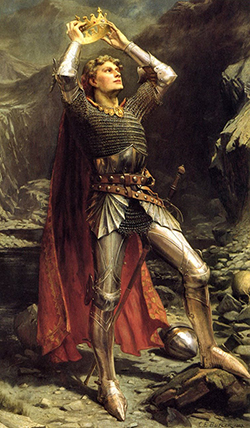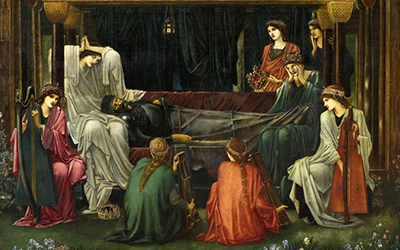
The Arthurian Legend
The legend of King Arthur has been told and retold throughout history. But where does this story of love, betrayal and adventure come from? Amy Brown, Doctoral Assistant in Medieval English at the Université de Genève, traces the origins of this magical tale.

This article is republished from The Conversation under a Creative Commons license. Read the original article or view the excerpt below.
The name Arthur first appears in the work of the 9th century Welsh historian Nennius, who lists twelve battles this Arthur fought against invading Saxons. Similarly, the Welsh Chronicles (written down in the 10th century) make some references to battles fought by Arthur. On this shaky foundation, along with a scattering of place-names and oblique references, is an entire legend based.
Ask any scholar of Arthurian literature if King Arthur really existed, and we’ll tell you: we don’t know, and we don’t really care. The good stuff, the King Arthur we all know and love, is entirely fictional.
The “Arthurian Legend” really kicked off in the early 12th century, with Geoffrey of Monmouth’s History of the Kings of Britain (1138), which purported to describe the entire history of Britain from the day dot until about the 7th century.
He describes the founding of Britain by the (mythical) Trojan warrior Brutus; he covers a lot of the historical events described in Nennius’ earlier work; and his account is the first to really describe King Arthur’s reign, his wars against the Saxons, and the doings of the wizard Merlin. Some elements, like the part where Merlin helps Arthur’s father Uther deceive and sleep with another man’s wife, thus conceiving Arthur, remain key parts of the Arthurian legend today. Other elements modern audiences expect, like the Round Table, are still absent.

Geoffrey of Monmouth wrote in Latin, and his book was read and treated as a history book in the Middle Ages. But very quickly, the material was re-worked into French and English poetry. The Norman poet Wace, whose audience included people living in both France and England, based his Roman de Brut (1155) on Geoffrey’s History. He added many things to the story, including the Round Table itself.
Around the turn of the thirteenth century, an English poet named Layamon took both Geoffrey and Wace’s works, combined them, and added more in his long English poem Brut. Arthur is not the only subject covered in the Brut, but it’s the first treatment of King Arthur in English.
These versions, and some of the later English romances like Of Arthur and of Merlin, focus on battles and political tensions. Aside from Merlin they feature few supernatural elements, and do not usually devote much attention to love. In these versions, the traitor Mordred who defeats Arthur at the battle of Camlann is usually his nephew, not his illegitimate son; and Guinevere may willingly marry him after Arthur’s death.

This article continues over at The Conversation and is republished under a Creative Commons license. Read the full and original article here.
Want more?
You can see Gabrieli Consort & Players perform Purcell's King Arthur on Saturday 16 and Sunday 17 February at Melbourne Recital Centre. Click here for more information and to book tickets.
You might also be interested in
-
-
-
Explore the program notes in advance

